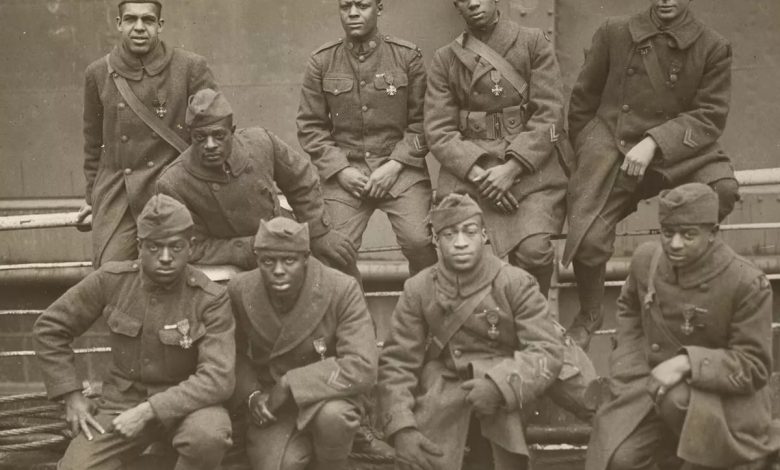Harlem Hellfighters awarded Congressional Gold Medal

Defense Secretary Pete Hegseth awarded the Congressional Gold Medal on Sept. 3 to the Harlem Hellfighters, one of the most renowned Black combat units of World War I.
Descendants of those soldiers were in attendance to accept the recognition, Congress’ highest civilian award, on behalf of their ancestors’ actions during a ceremony in Washington, according to a DOD press release.
Highly decorated, the 369th Infantry Regiment was initially nicknamed the “Black Rattlers” for the rattlesnake insignia that adorned their uniforms.
The French called the unit “Men of Bronze,” while it is believed that they gained their “Hellfighter” moniker from their German foes owing to their courage and ferocity in combat, according to the National Museum of American History and Culture.
The Hellfighters, like many non-white demographics in the 20th century, were forced to fight a war on two fronts. Before, during and well after the carnage of WWI, racism encountered by Black soldiers by their white American counterparts was severe.
In his correspondence, Pershing claimed the men of the 369th were “inferior” to white soldiers, acted as a “constant menace to the American” and didn’t possess a “civic and professional conscience.”
Burdened by a misguided reputation, the Harlem Hellfighters were initially relegated to labor-intensive duties. That was until they were ordered into battle in 1918 and assigned to the French Army, who seemed to care far less about race than their American allies.
It would be among the 16th Division of the French Army that the Harlem Hellfighters would learn how to survive the slog of trench warfare.
Such experiences, meanwhile, were left out of the Pentagon’s announcement this week, which only briefly acknowledged “racial tensions that came with serving in a segregated Army stateside.”
The all-Black unit would go on to spend 191 days in continuous combat, more than any other American unit of its size. During that time, about 1,400 soldiers were killed or wounded — suffering more losses than any other American regiment during the war.
According to the bill, the “369th never lost a foot of ground nor had a man taken prisoner, despite suffering a high number of casualties.”
“After the war,” writes the NMAHC, “the French government awarded the coveted Croix de Guerre medal to 171 members of the regiment, as well as a Croix de Guerre citation to the unit as a whole.”
Among those men was Henry Johnson, whose bravery on May 15, 1918, led to him being posthumously awarded the Medal of Honor in 2015.
Johnson was standing guard with 17-year-old Needham Roberts early that morning when heard “snippin’ and clippin’” sounds of at least 12 Germans cutting their way through the wire encircling the guard post.
In the dark, Johnson tossed a grenade in the direction of the commotion and all hell broke loose. The German invaders unleashed a wall of gunfire and grenades toward the two watchmen, injuring Needham Roberts immediately.
Unable to walk, Roberts sat upright in the trench and continued to feed Johnson grenades — but the Germans kept coming.
Johnson quickly exhausted the supply and switched to his rifle. It jammed. Enemy soldiers were close enough to touch.
When the Germans attempted to grab Roberts from the trench and take him prisoner, Johnson, who stood at only 5-foot-4 and 130 pounds, went to work, abandoning the cover of the trench and swinging his rifle, fists and bolo knife in a blur of clubbing, punching and cutting.
“Each slash meant something, believe me,” Johnson recalled.
It was later determined by observers that Johnson killed four of the enemy and wounded upwards of a dozen more.
Of his feat, the self-effacing private later recalled, “there wasn’t anything so fine about it. Just fought for my life. A rabbit would have done that.”
In June 2023, the Louisiana installation Fort Polk shed its Confederate namesake to honor Johnson, who suffered 21 injuries in the melee, including bullet and stab wounds to his head, torso, right arm and left leg, as well as a shattered left foot.
This past July, Hegseth, who presented the Gold Medal to Hellfighter descendants this week, personally oversaw the stripping of Johnson’s name from the base in favor of returning it one adjacent to its Confederate past — Gen. James H. Polk, who was awarded the Silver Star for his World War II service.
The Hellfighters initially received a hero’s welcome at war’s end, but their fame quickly faded into a small coda of WWI history largely due to the nation’s virulent racism.
Johnson himself contracted tuberculosis and later died, destitute, in July 1929 of myocarditis at the age of 36. He is buried in Arlington National Cemetery.
And while more than a century has passed since their heroic deeds, Congress has given recognition where it is due.
“The symbol of the men we honor today as the Harlem Hellfighters; the symbol of these soldiers who were the bravest Americans,” Hegseth said during the ceremony.
“We ought always thank almighty God for such men; and may we honor them forever, especially because they were not honored in their time,” he concluded.
Claire Barrett is the Strategic Operations Editor for Sightline Media and a World War II researcher with an unparalleled affinity for Sir Winston Churchill and Michigan football.
J.D. Simkins is the executive editor of Military Times and Defense News, and a Marine Corps veteran of the Iraq War.
Read the full article here









